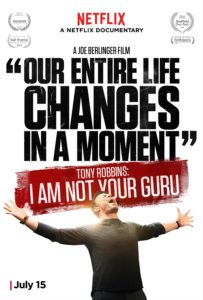 Anyone who’s spent even half as much time watching TV at odd hours in the late 80s through the 90s will recognize Tony Robbins immediately. His infomercials were ubiquitous in those wee hours and, as he became better known, ads for his books and seminars would seep into various other viewing hours. He’d show up, or be mentioned, on various shows and in movies (notably being the catalyst for the entire plot of Shallow Hal), and, of course, all over the place in daytime TV and late night talk shows.
Anyone who’s spent even half as much time watching TV at odd hours in the late 80s through the 90s will recognize Tony Robbins immediately. His infomercials were ubiquitous in those wee hours and, as he became better known, ads for his books and seminars would seep into various other viewing hours. He’d show up, or be mentioned, on various shows and in movies (notably being the catalyst for the entire plot of Shallow Hal), and, of course, all over the place in daytime TV and late night talk shows.
When people say “Self Help Guru” there’s a good chance Robbins will be the first person who comes to mind–in part due to that long-time ubiquity in the public consciousness, in part due to his distinct look. You can say “Everyone knows him” and only be guilty of a slight hyperbole.
In all that time, through all the profile pieces and interviews, there was never a really solid documentary about what his events are actually like. Sure, you can shell out the money for the DVDs of his big seminars or, if you’ve really got the cash to burn, pay a few thousand to attend one of the big ones yourself. Or, as of July of 2016, you can pop over to Netflix and watch Tony Robbins: I Am Not Your Guru.
Filmmaker and documentarian Joe Berlinger (who’s made more than a few documentaries I’ve seen over the years) managed to get himself pretty much full access to one of Robbins’ big annual seminars: the 6-day, 2500-attendee, “Date with Destiny” (the next of which has ticket prices ranging from $3995-$7995).
The result is relatively impressive.
The Rundown
Berlinger knows how to weave reality into a good story. So does Robbins. That makes the in-seminar bits of this documentary pretty spectacular. The drama of the moments, the emotions that run through not just the person in the spotlight, but the whole crowd, is palpable. They’re almost the kind of bits you’d see in an ad for the seminar.
But there are also the rougher bits… the shots of doubt, of defiance, of utter breakdown. The stuff that you wouldn’t necessarily put in an infomercial, but that illustrate that we are, indeed, seeing real people go through real life-changing moments.
The real gold here, though, is the out-of-seminar stuff. Behind the scenes with Robbins as he prepares to hit the stage, as he cools down between segments, as he runs the business end of the whole show. Those bits are the meaty parts for anyone who thinks this is anything other than a well-oiled machine, honed over decades of practice.
Also part of the “golden bits” are the out-of-seminar interviews with the staff and attendees. These are people who believe in what they’re there to do (as well they should, for the amount of money they paid). They’re all working hard. The staff to ensure the well-being of the attendees as they go through some serious emotional challenges and the attendees to deeply dig into themselves with the “homework” exercises Robbins assigns.
This is no walk in the park for anyone.
What really brings it all together, though, are the follow-ups done at the very end. Where Berlinger catches up with the attendees whose stories are featured most prominently during the in-seminar parts of the documentary. These follow-ups go a long way to smoothing over what I considered some questionable advice given during one of the segments. (If you watch this documentary, you’ll likely have the same “wait a minute” moment I did.)
The Verdict
Whether or not you like Robbins methods or business model, check this out to see his technique. The man is an expert in what he does. Of that, there is no question. His work ethic and passion are also beyond reproach.
If you’ve ever wondered “What’s the big deal?” about him, but you were never willing to drop any cash to learn more, this is the documentary for you. If you’ve ever wondered how these “self help guys” work with people, watch this–a lot of the younger people in the industry out there have learned directly from Robbins (or, at least, have him as a serious influence).
Finally, if you just want a solid example of a good documentary, check this out. It’s about as far from dry and clinical as you can get. It could be a little more critical in places, but it’s far from a pandering feel-good piece.
It’s a profile of a man who’s dedicated his life to a specific purpose… and the people who come to him hoping to be helped.
His overall goal? Not to be the guru they come to and bow before, but to be the person who gets them to stand up and take him on toe-to-toe with an amount of passion for their lives that matches his.

Leave a Reply